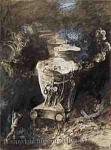Graham Vivian Sutherland
Graham Vivian Sutherland
Place: Streatham
Born: 1903
Death: 1980
Biography:
Graham Vivian Sutherland OM was an English artist who is notable for his work in glass, fabrics, prints and portraits. His work was much inspired by landscape and religion, and he designed the tapestry for the re-built Coventry Cathedral.
Printmaking, mostly of romantic landscapes, dominated Sutherland's work during the 1920s. He developed his art by working in watercolours before switching to using oil paints in the 1940s. It is these oil paintings, often of surreal, organic landscapes of the Pembrokeshire coast, that secured his reputation as a leading British modern artist. Sutherland taught at a number of art colleges, notably at Chelsea School of Art and at Goldsmiths College, where he had been a student. He served as an official war artist in the Second World War drawing industrial scenes on the British home front.
Such was Sutherland's standing in post-war Britain that he was commissioned to design the massive central tapestry in the new Coventry Cathedral. A number of portrait commissions in the 1950s proved highly controversial. Winston Churchill hated Sutherland's depiction of him. After initially refusing to be presented with it at all, he accepted it disparagingly as “a remarkable example of modern art".
In 1955, Sutherland and his wife purchased a property near Nice. Living abroad led to something of a decline in his status in Britain. However, a visit to Pembrokeshire in 1967, his first trip there in nearly twenty years, led to a creative renewal that went some way toward restoring his reputation as a leading British artist.
Graham Sutherland was born in Streatham in London, the son of a lawyer who later became a civil servant in the Land Registry Office and the Board of Education. Graham Sutherland attended Homefield Preparatory School in Sutton and was then educated at Epsom College, Surrey until 1919. Upon leaving school, after some preliminary coaching in art, Sutherland began an engineering apprenticeship at the Midland Railway locomotive works in Derby as several members of the extended Sutherland family had previously worked there. After a year he succeeded in persuading his father that he was not destined for a career in engineering and that he should be allowed to study art. There being no vacancies at his first choice, the Slade School of Fine Art, he entered Goldsmiths' School of Art in 1921, specialising in engraving and etching before graduating in 1926. In both 1925 and 1928, Sutherland exhibited drawings and engravings at the XXI Gallery in London. While still a student Sutherland established a reputation as a fine printmaker and commercial printmaking was to be his main source of income throughout the late 1920s.
Sutherland's early prints of pastoral subjects show the influence of Samuel Palmer, largely mediated by the older etcher, F.L. Griggs. He did not begin to paint in earnest until he was in his 30s, following the collapse of the print market in 1930 due to the Great Depression. These pieces are mainly landscapes, which show an affinity with the work of Paul Nash. Sutherland focused on the inherent strangeness of natural forms, abstracting them to sometimes give his work a surrealist appearance; in 1936 he exhibited in the International Surrealist Exhibition in London. Sutherland converted to Catholicism in December 1926, the year before his marriage to Kathleen Barry (1905-1991), who had been a fellow student at Goldsmith's College. The couple, who were inseparable, lived at various locations in Kent before eventually buying a property in Trottiscliffe in 1945.
Sutherland also took up glass design, fabric design, and poster design during the 1930s, and taught engraving at the Chelsea School of Art from 1926. Between 1935 and 1940, he also taught composition and book illustration at Chelsea. In 1934 he visited Pembrokeshire for the first time and was profoundly inspired by its landscape, and the region remained a source for his paintings for much of the following decade. Sutherland visited the area every year, until the start of the Second World War. Oil paintings of the Welsh landscape dominated his first one-man exhibition of paintings held in September 1938 at the Rosenberg and Helft Gallery in London.
At the start of World War Two, the Chelsea School of Art closed for the duration of the conflict and Sutherland moved to rural Gloucestershire. Between 1940 and 1945, Sutherland was employed as a full-time, salaried artist by the War Artists' Advisory Committee. He recorded bomb damage in rural and urban Wales towards the end of 1940, then bomb damage caused by the Blitz in the City and East End of London. Almost all of Sutherland's paintings of bomb damage from the Blitz, either in Wales or in London, are titled Devastation:... and as such form a single body of work reflecting the needs of war-time propaganda, with precise locations not being disclosed and human remains not shown. A number of features reoccur within this body of work, for example, the fallen lift shafts that were often the most recognizable aspect of larger bombed buildings and a double row of bombed houses Sutherland saw in the Silvertown area of the East End.
More...
Wikipedia link: Click Here














